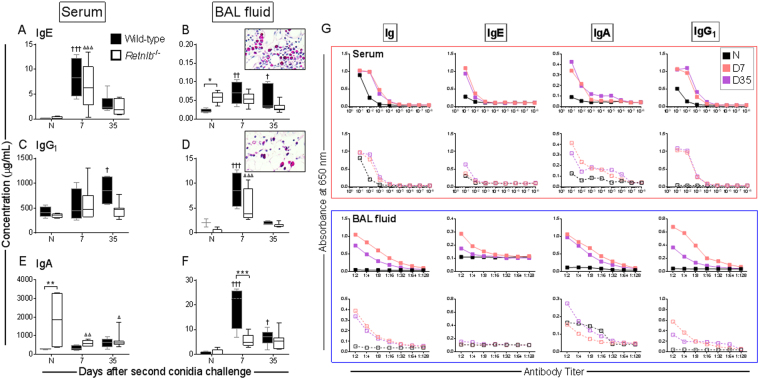Figure 6.
Systemic and local antibody responses were induced in both wild-type (WT) and Retnlb null mice (KO). Antibody levels in the serum and bronchoalveolar lavage (BAL) fluid were measured at each time point after the second fungal challenge. Allergen exposure led to an increase in immunoglobulin (Ig) E levels in the serum (A). IgE in the BAL fluid also increased after allergen exposure in WT mice, but did not change over baseline in the KO group which had significantly more IgE at baseline, compared to WT (B). Serum IgG1 levels increased after allergen challenge but did not reach significance until the late time point in the WT mice (C). Changes in the mucosal IgG1 was apparent at early time points in both groups (D). Steady state systemic IgA was high in the KO mice, which reduced after allergen challenge while WT IgA in the serum increased minimally over naïve controls (E). IgA levels in the BAL fluid increased in response to allergen provocation in the WT and this increase was delayed in the KO, but did not reach statistical significance (F). More Mott cells (magenta coloured) were noted in the WT lungs (inset B) than in KO (inset D). Aspergillus fumigatus-specific antibodies were produced in both groups but generally more abundant in the WT mice compared to KO (G). Data are represented as the mean and SD of n = 4–7 mice/group in one representative study of two independent studies. Data shown as range from minimum to maximum where lines and dots represent the median and mean respectively. Data analysed with two-way ANOVA with Sidak’s and Dunnett’s multiple comparisons test to compare data between groups at each time point (*) or to naïve controls within groups († in WT and Δ in KO) respectively where significance values p < 0.05, p < 0.01, and p < 0.001 are denoted by one, two, or three symbols respectively. N – Naïve; D – Day.

